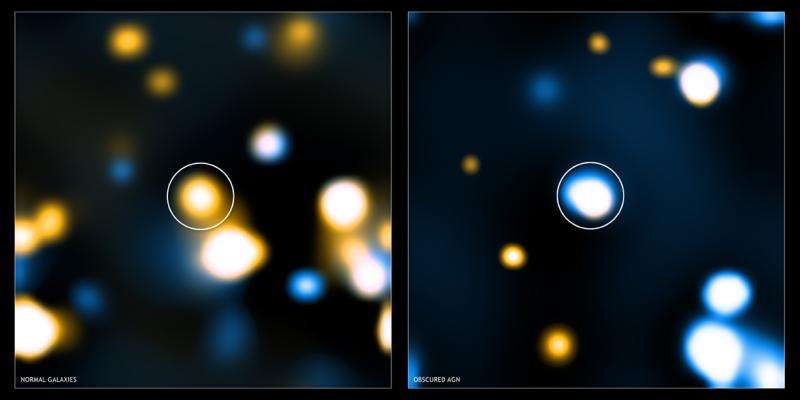Obscured supermassive black holes in galaxies

Most if not all galaxies are thought to host a supermassive black hole in their nuclei. It grows by accreting mass, and while feeding it is not hidden from our view: it generates X-ray emission and ultraviolet that heats the dust which in turn radiates in the infrared. During the evolutionary phase in which it is most active, the object is known as an active galactic nucleus (AGN). The vast majority of AGN reside in normal galaxies in which the activity of star formation co-evolves with the black hole accretion, but astronomers disagree about the nature of the host galaxies, and in particular whether they resemble normal star forming galaxies in their overall structure.
The main problem lies in the difficulty of distinguishing the contribution the AGN makes to the emission from that of the host galaxy. Even images from the Hubble Space Telescope are unable to distinguish the nuclear component when there is significant dust obscuration in the galaxy. These so-called "obscured AGN" contribute only weakly to the optical emission since it is absorbed by the dust. However, the ones studied to date are extremely luminous overall, with among the largest total luminosities known, equivalent to more than ten billion Suns.
CfA astronomers Francesca Civano and Stefano Marchesi and their colleagues prepared a precisely defined sample of obscured AGN—those whose infrared emission is more than twenty times larger than its X-ray emission (the X-ray emission was measured by the Chandra X-ray Observatory). They first collected a set of 265 AGN and then determined which ones were "obscured" by calculating the infrared emission of each to ratio with its X-ray emission. They did this by assembling the full spectral distribution of the radiation, combining infrared with UV and optical data and then modeling the entire distribution to determine the total infrared component from the AGN alone with a code that models and subtracts the contributions from stars and other processes. Once they had the infrared value, they could tell which ones qualified as "obscured." Their final sample of obscured AGN had 182 objects.
They next analyzed the very faint optical images of the nuclear regions of this set by combining them all into a composite image, and found that the nuclear region in this generic image was unusually compact in angular size, more than twice as small as the corresponding regions in star formation galaxies. The scientists argue that these obscured AGN must have undergone a process of contraction perhaps, as suggested by some simulations, when cold streams of gas flow into the galaxy and drive material to the nucleus, making them compact. The results are significant not only because they help to clarify what is happening in this class of X-ray bright AGN, but also because something like this process seems to be underway in galaxies in the early universe which have the appearance of also being unusually compact.
More information: Yu-Yen Chang et al. Obscured active galactic nuclei triggered in compact star-forming galaxies, Monthly Notices of the Royal Astronomical Society: Letters (2017). DOI: 10.1093/mnrasl/slw247
Journal information: Monthly Notices of the Royal Astronomical Society Letters
Provided by Harvard-Smithsonian Center for Astrophysics




















